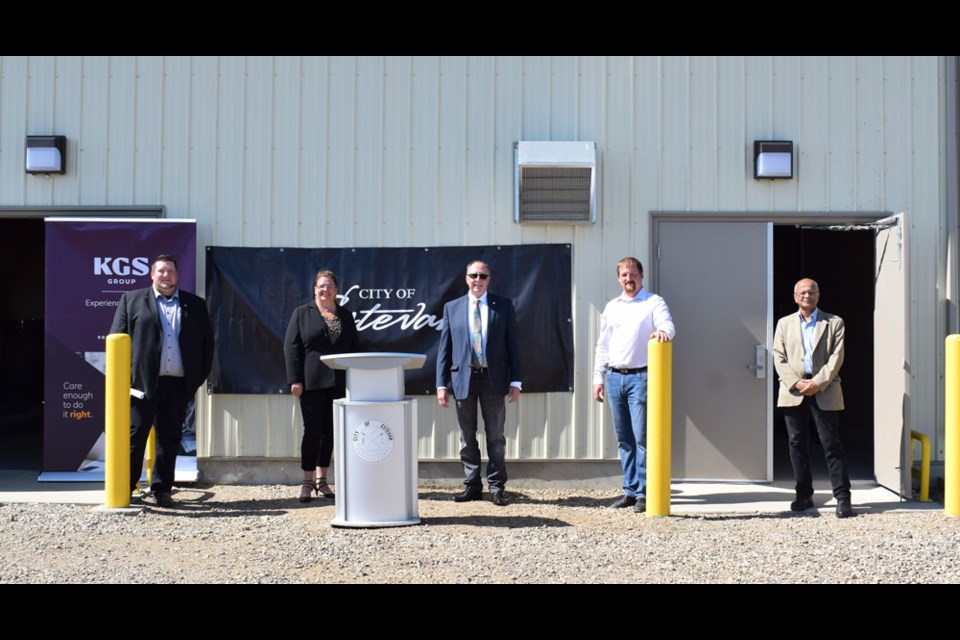Estevan will start receiving better quality water in a matter of a few weeks.
The upcoming completion of the third and final phase of the community’s drinking water system upgrade project was celebrated at a ceremony near Rafferty Dam, hosted by the City of Estevan Thursday morning.
Minister of Government Relations and MLA for Estevan Lori Carr joined Estevan Mayor Roy Ludwig at the ceremony. City manager Jeff Ward, councillor Travis Frank, water and wastewater services manager Shane Bucsis, his predecessor Kevin Sutter, who stood at the base of the project, and representative of the primary consultant company KGS Milan Vora were joined by others for the celebration.
Now that all the major construction is completed, the city’s primary water source will very soon shift from Boundary Dam to Rafferty Dam. The switch will allow the city to have better water, but will also be beneficial for the environment.
“These upgrades will help be safe for the environment now and into the future,” said Ward.
In the coming weeks, residents who access this city utility will notice their drinking water quality will be noticeably improved and not as hard. This will mean reduced wear on water heaters, faucets and plumbing, while settings on home water softeners will need to be updated. The city will advise residents via their regular utility bills when this change needs to occur to accommodate this enhancement to the water system.
“From initial water quality tests, residents should notice a huge improvement in their water,” said Bucsis.
The water intake project is part of a multi-year initiative in Estevan that received provincial and federal support.
The project began in 2017 with construction that finished that same year on two settling ponds that store the residuals generated by the water treatment plant, to help protect the Souris River. The ponds, which didn’t exist previously at the facility, alternate collecting the residuals, as part of the water treatment process.
The water intake project included a 9.2-kilometre water pipeline, which runs from the original riverbed in the Rafferty Dam Reservoir to the Estevan Water Treatment Plant. The final phase of the project was the intake line from the dam and the construction of a pump house, which will soon be operational.
Catherine McKenna, the federal minister of infrastructure and communities, was unable to attend the ceremony but sent her statement that Ward read to attendees.
“Having access to clean reliable drinking water is critical to the health and prosperity of Canadian communities … We are proud to be a partner in this important project that provides residents of Estevan with the modern and efficient water infrastructure that meets their needs,” said McKenna in the statement. “Canada’s infrastructure plan invests in thousands of projects, creates jobs across Canada and builds stronger communities.”
She added that the Government of Canada has invested over $715 million towards 368 infrastructure projects across Saskatchewan, all of which are either underway or completed.
“Thanks to these initiatives, projects like the City of Estevan water treatment plant’s upgrades, Canada remains among the best places to live, work and raise a family,” finished McKenna.
Carr spoke on behalf of the provincial government, which also covered a third of the expenses.
“The Government of Saskatchewan is proud to play a key role in this important City of Estevan initiative by investing $3.1 million toward this project, which will help safeguard the environment and improve water quality for the community. We recognize it’s critical for the province to contribute to improving local infrastructure and to improve quality of life for all Saskatchewan residents.
“That’s why our government’s $7.5 billion, two-year provincial capital plan will also help stimulate economic recovery from the impact of the COVID-19 pandemic and build a stronger Saskatchewan,” said Carr.
Carr also pointed out that the province is “well-positioned to recover from the effects of the COVID-19 pandemic. Its fiscal foundation remains solid. And the government continues investing in communities.”
She also thanked Sutter for being the catalyst for the project that was carried forward by Bucsis.
The mayor also noted Sutter’s and Bucsis’s role in the project, and was pleased to see the significant work coming near to completion.
“We are excited to see a project of this size come to fruition,” said Ludwig. “This project has been several years in the making and we are happy to be able to announce that residents will have cleaner water with fewer trihalomethanes.”
Bucsis thanked all bodies that contributed to the project and gave some details about it.
“The project consists of the pumphouse (at the coast of Rafferty Dam), the intake, which is sitting about 200 metres out into the water, and an air purge system that clears the screen of debris. The air purge system protects the environment by us not having to pump any chemicals to clean the screen protecting the aquatic life,” said Bucsis.
Collaboration with SaskPower allowed the city to save some money and keep the cost of the project down by using over five kilometres of existing SaskPower pipeline instead of laying the new ones.
Through the Provincial-Territorial Infrastructure Component – National and Regional Projects program, the governments of Canada and Saskatchewan are each contributing up to $3.1 million toward the Estevan Water Treatment System Upgrades Project. The City of Estevan is responsible for any remaining costs of the project, which has a total eligible cost of $9.4 million under the program.
After final conditioning is completed the project will be finished and Estevan will switch to the new raw water source. From that point and on, the city will have two potential sources of raw water.
While regularly receiving better quality water from Rafferty Dam, in case of an emergency, the city will be able to switch to the old source at Boundary Dam and keep supplying the treated water to the residents.
Check the coming editions of the Mercury for the announcement of the final switch to the new water source.




